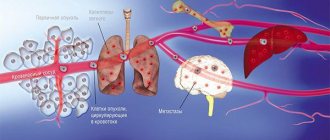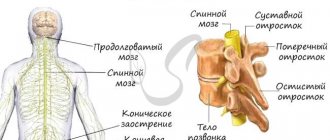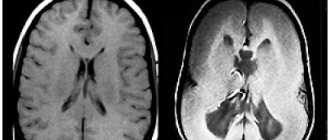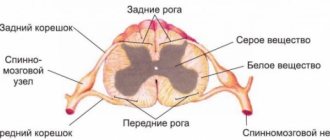Refutation of the theory
Modern scientists, in particular, neuroscientist B. Gordon, have provided several arguments that completely refute the myth of 10% brain use. These include:
- During natural selection and the passage of stages of evolution, only the characteristics that were significant for a particular species were selected. If 90% of the brain did not perform any functions, then, accordingly, in the process of evolution, these parts of the central nervous system would disappear.
- Modern research methods, that is, various scans, make it possible to determine the absence of blind spots in brain activity. The appearance of inactive areas is observed only in individuals who have some kind of brain damage.
- It has been experimentally proven that each part of the brain is responsible for a specific function. If a part of the brain is damaged, in any case, some kind of disturbance in central nervous activity will occur.
- It has been proven that every single brain cell is functionally active.
- In the course of research, it turned out that non-use of any part of the human body (part of an organ or even a limb) leads to its atrophy, and in some cases to replacement with connective tissue. If there were inactive areas in the brain, they would atrophy or degenerate.
The Myth of the Brain
It is not true! The statement that the human brain works at 10% (5%, 3%) is an old, completely false and completely unkillable myth. Let's figure out where it came from.
In the middle of the last century, it was completely incomprehensible how a person thinks (now this is also incomprehensible, but on a different level). But some things were known, such as that the brain is made of neurons and that neurons can generate electrical signals.
Some scientists then believed that if a neuron generates an impulse, then it is working, and if it does not generate, it means it is “lazy.” And then someone came up with the idea to check: how many neurons in the whole brain are “working”, and how many are “throwing their thumbs”?
There are several billion neurons in the brain, and it would be pure madness to measure the activity of each of them - it would take many years. So instead of studying all the neurons in a row, scientists examined only a small part, determined the percentage of them that were active, and assumed that this percentage was the same throughout the brain (this assumption is called extrapolation).
And it turned out that only an indecently small percentage of neurons “works,” that is, generates impulses, and the rest are “silent.” From this, a somewhat straightforward conclusion was drawn: silent neurons are slackers, and the brain works only at a small part of its capabilities.
This conclusion was absolutely wrong, but since at that time it was customary to “correct nature”, for example, turn rivers back, irrigate deserts and drain seas, the idea that brain function could also be improved took root and began its victorious march through the newspapers. pages and magazine spreads. Even now, something similar is sometimes found in the yellow press.
Human brain - interesting facts
The brain is a system that amazes with its abilities, sometimes they can even seem mystical. We have already mentioned the main functions of the organ, but there are facts that not everyone knows.
No difference between reality and fantasy
During reflection, information enters the brain, where it is processed. However, he does not distinguish between the nature of an opinion, whether it is real or a figment of the imagination. In this situation, the expression “wearing rose-colored glasses” would be appropriate. The person feels happier, so it cannot be said that this is harmful. It is important that we ourselves learn to differentiate between reality and fantasy.
The brain works continuously and does not get tired
Throughout the day, the brain does not stop functioning. During sleep, its maximum activation is also observed. Data from studies indicate that the organ expends maximum energy when it is overloaded with a psycho-emotional nature, but mental activity does not tire it at all.
After waking up, the brain does not begin to function immediately
Quite often, after waking up, we feel lethargic; this is associated with a temporary decrease in intelligence. To improve overall well-being and stimulate brain activity, it is recommended to perform physical or logical exercises.
Human memory can only contain 7 objects
It is customary to distinguish three types of memory - sensory, long-term and short-term. The fact that a person can remember no more than 7 objects concerns short-term memory. We are considering a person with average abilities.
What is good for the brain and its activities
The human brain performs many functions, so it requires more energy compared to other organs. Thanks to this, intelligence improves and new nerve impulses are formed. To stimulate the functional abilities of the organ, it is recommended:
- Read books. Changing genres will be useful, thanks to this your thinking will improve.
- Exercise. Physical activity stimulates the production of the hormone endorphin, which improves mental performance.
- Relaxing during the day will improve the process of assimilation of information.
- Sleep well. Thanks to this, it will be possible to improve concentration and memory.
- To refuse from bad habits. Smoking and drinking alcoholic beverages leads to the death of neurons.
- Follow the rules of rational nutrition.
- Do modeling and drawing. Such activities promote the development of fine motor skills, which improves organ function.
- To learn foreign languages.
Brain power
Every second our brain performs many operations, this number is very difficult to calculate if you take into account such simple things as: sitting up straight, holding your head, listening, seeing, feeling and many, many others. You simply can’t imagine how many processes are involved at the same time. This is ensured by the exchange of information between 100 billion neurons, each of which has about 10,000 synaptic connections with other neurons and is capable of transmitting about 10 impulses to each of these connections in 1 second. Try to do the math, humanists are indignant) However, we don’t notice the vast majority of these operations due to habituation, but this does not mean that they don’t work! To fully experience some of them, count how many times you inhale/exhale and blink your eyes per minute. Even a banal movement to scratch the back of your head gives commands to the hand, not the leg, sets the optimal speed of hand movement so that you do not receive a reward for the most ridiculous death, and so on. Why can't we multiply huge numbers by each other? Because it’s not as important to us as learning to scratch our heads, quite simply.
There is also a hypothesis that the brain does not perform many actions simultaneously, but sequentially, but at an incredible speed.
The main secrets of the human brain that are beyond the control of scientists have been revealed
– Svyatoslav Vsevolodovich, tell us what new scientists have learned about the human brain in recent years?
– Recently, at one of the sessions of our Department of Physiological Sciences dedicated to brain research, we all came to the conclusion that there have been no serious breakthroughs in this area of knowledge in recent years. And this situation is observed not only in Russia, but throughout the world of brain science.
– Well, have you already answered any questions? For example, does the average person really only have 10 percent of their brain working and the rest in reserve?
- No, that's not true. Our brain makes the most of everything that is given to it by nature.
– Is the brain really the most energy-consuming organ?
– Yes, compared to other organs. If you take the intellectual power of the brain, it will be more powerful than all the computers that exist on Earth, but it consumes energy like an average light bulb.
— Is the number of nerve cells known?
– Maybe a billion, or maybe a hundred billion. They are very difficult to count due to the fact that they all have different shapes.
– Is it already known about the main difference between the human brain and the animal brain?
This is the most difficult question - there is no answer to it yet. And moreover, it is not clear why our brain arose in this particular form, because at first we did not need it of this size for survival. We still have not found a transitional bridge between Pithecanthropus and Homo sapiens. We have the genes of Neanderthals, but why they at some point turned aside and did not go further with us is also not clear.
A “spot of light” moves in our brain
– Do your foreign colleagues ask themselves the same questions?
- Certainly. Only we have different approaches to studying the brain. They start from specific changes, from instrumental measurements, but we have developed a completely different approach. We still have the physiological schools of Sechenov, Pavlov, and Bekhterev, which primarily studied general laws. Our Western comrades sometimes do not know much of what we know.
The same Ivan Petrovich Pavlov proposed the concept of a “light spot”. “If we could see a system of excitations spreading across the cortex of a waking animal (or person), we could observe a moving horse, moving along the cortex as we move from one activity to another and personifying the point of optimal excitation, without which normal performance of the activity is impossible.” .
In other words, depending on the type of activity in our brain, one or another area is always involved in work. And previously it was believed that only she was dominant.
But it turned out that the “light spot” was just the tip of the iceberg. In our laboratory, we came to the conclusion that the main control system that forms such a spot is hidden in the depths, spreads to different parts of the brain and works without manifesting itself in any way.
For example, when a person pronounces words, we detect excitement in his so-called Broca's area. But it can be compared to the speaker on a TV. Most of the work happens in a large, coordinated network of neurons spread throughout the brain. Figuratively speaking, if a person has a need to say something, then a conditional “speech director” gets involved, which begins to involve the necessary parts of the brain, involving Broca’s area, which we can measure.
– Can there be many such “directors” in our brain, for each function, or just one?
— This is a very complex and controversial issue. There is an opinion that there is a “director” for each type of activity. So to speak, the “grandmother neuron”, where information about the grandmother is recorded, or the face of an actress, etc. I don’t agree with this. Apparently, there is a complex network of systems that are adaptively formed when it is necessary to carry out some kind of activity. These are the same neurons that are activated differently.
Therefore, before each operation, we first use MRI to identify all areas that may be involved in the process. In 1987, we had a patient whose skull was fractured with a bottle. He developed complete aphasia (disorder of speech and its perception). When they opened the skull, they saw a real “mess” there, in Broca’s and Wernicke’s areas (the areas of speech generation and perception). But by introducing electrodes near these areas, through therapeutic electrical stimulation, we transferred the task of speech formation and understanding to other cells. After a few weeks, the patient was already speaking and understanding everything. He's still alive.
World progress is slowed down by the “error detector”
– I heard that you are conducting a study of the memory process.
– Other Russian researchers are studying memory, for example, members of the Russian Academy of Sciences Konstantin Vladimirovich Anokhin and Pavel Miloslavovich Balaban. They have already learned to erase unpleasant memories from mice. We have a slightly different direction. I’ll tell you in more detail about one of the mechanisms of brain function, which was discovered in 1986 by the former scientific director of our institute, Natalya Petrovna Bekhtereva. This is the so-called “error detector”.
Imagine leaving the house and feeling: something is wrong. We do such ordinary things as turning off the stove and electricity automatically. But as soon as we forget to do something, the “error detector” immediately compares your actions with what is recorded in your memory. And it signals, sending waves of discomfort from somewhere in the subconscious.
The same “error detector” is triggered in a mature person who already knows how a reckless jump into the water from a high cliff in an untested place can end. Young children do not yet have such a detector; the matrix, that is, a set of certain rules, has not yet been formed, and therefore they often fall, get bumps, but, nevertheless, retain the ability to perform unexpected, drastic actions. A striking example of this is the story of Niels Bohr, the founder of the first quantum theory of the atom, which differed from the classical theory. The arguments of the young and talented researcher seemed absurd to many established luminaries of science at first.
The ability to take risks, regardless of ranks and titles, persists, as a rule, until 35-40, after which the “error detector”, which has entered into full force, no longer allows you to commit “nonsense”. Not a single outstanding discovery in the field of mathematics or theoretical physics was made by scientists after 40 years.
A 50-60 year old person is no longer capable of a crazy idea. He knows too much for that. This is a phenomenon of aging physicists and mathematicians. Why did the greatest mathematician of the 20th century, Andrei Nikolaevich Kolmogorov, at the age of 50, leave to teach mathematics to schoolchildren? He lost his fire, and this is a completely physiological thing.
Or take the Brezhnev Politburo. After all, people of extraordinary intelligence worked there. But over time, at some stage, they could no longer change the policy; the overwork of their “error detectors” did not allow the bold idea to be “put into practice.” Why did the putsch then fail? They were not young.
We are now talking about prolonging life and its quality. The percentage of elderly people in society is increasing. Few people think about this, but with the aging of society, civilization sharply loses the opportunity to develop. There are fewer and fewer young and daring people and more and more old and cautious ones. Work on studying the “error detector” is very important if we want to prolong life and advance scientific and technological progress. There is no answer yet to one of the most important questions: how to protect a person from the overprotectiveness of the “error detector,” although this is one of the main directions of our work.
By the way, the influence of the “error detector” on our lives does not always introduce elements of stagnation. If you take the professions of a lawyer, a lawyer, a doctor, where you need to have vast experience, then here this mechanism sometimes works real miracles. I would give as an example the life of the famous cardiologist, academician Vladimir Andreevich Almazov. He approached the patient and, without touching him, could say that his heart was not on the left, like everyone else, but on the right, he could make a diagnosis simply by looking at the person. His error detector was so trained that it made it possible to determine the subtlest differences invisible to others between ordinary and unusual patients.
How to recognize a genius
– Is it possible to identify people who will be successful in different fields of science based on the configuration of the active zones of the brain?
- It is forbidden. There is one science fiction novel in which aliens from another planet want to find the most outstanding commander. They are taken to the shoemaker. He was ideally suited to lead the army, but instead wears boots. He did not have to use his abilities in military affairs. So, despite all the “correct” data from the brain, life circumstances may interfere with a person’s path to success in one activity or another.
Many people have talent hidden somewhere deep in their nature. Some have enough character reactivity to show it, others do not. There are people who do not shine with talent, but thanks to their desire and hard work, they come forward, leaving behind those who were initially more talented.
– Even obvious geniuses?
– I don’t talk about them. No matter how much a person works, it will still not be possible to become like Leonardo da Vinci, Einstein or Mozart without the appropriate genetics. There is no need to force such people to study; they themselves will not be able to sit idle.
– What advice could you give to parents?
“You can’t force someone to teach reading and writing before the child is ready for it.” It's the same as simulating a Pentium on an old 286 model computer. It will work, but very slowly, creaking and puffing.
Likewise, children should not be forced to put complex concepts into their little heads prematurely. They will learn the subject poorly, and forever. If you start teaching them to write when the motor center of the brain is not yet developed, it will take them a lot of effort to overcome this problem, and the result will still not be the best.
The only thing I would recommend teaching young children under 5-6 years of age is foreign languages, and only by ear.
– How many languages can you teach them?
- One is enough. We must leave time for fairy tales and games in the yard.
– Has electromagnetic waves been proven harmful to the brain?
— This issue has been studied for 30 years. And there is still no clear answer. But I would advise, just in case, to beware of talking too long on a mobile phone while holding it to your ear. For example, now I’m talking to you on the phone in speakerphone mode...
It is not recommended to carry your phone in your breast pocket. Why? It often happens that when you enter an area with a weak signal, your phone turns on the radiation at full power to find a connection. So far, there has been no evidence of obvious harm from this, but just in case, we must choose a reasonable line of behavior. Here we can cite as an example the words of one Nobel laureate. When he was asked: “Why don’t you start anything on Monday - do you really believe in omens?”, he jokingly replied: “I don’t believe in them, but I’m afraid of them.”
Myth or true?
Let’s not drag our feet in vain: the theory that the human brain works at only 10 percent is a real myth. Its distribution is beneficial to people who are having discussions about the incredible potential of the human brain, and the enormous possibilities that a person would have if he used the brain at 100 percent.
Just imagine what endless possibilities will open up for a person if the brain suddenly begins to work 10 times more productively than it does now. We are likely to see a complete cure for humanity from all diseases, contacts with extraterrestrial civilizations, and other miracles. What an evolutionary advantage we would have! It is undoubtedly pleasant to think so, but it is all just a fantasy.
In fact, a person already uses the brain 100 percent. We use every part of our gray matter; there are simply no additional hidden reserves. The human brain does not use 100 percent of its capacity only in one case: there is a brain injury.
Now you understand what the catch is!
A few words about such a concept as “déjà vu”. This is when you experience the feeling that you have already been in “this” place, with these people, etc., in short, an almost exact repetition of past events. This is the very “awakening of sleeping” neural connections + a little imagination. You might have had a dream that you have long forgotten, but then a very similar situation happens. When neurons have found a match for visual, auditory, sensory characteristics in other neurons, but these connections are weak and you can only feel, due to neurotransmitters, that “this has already happened somewhere.”
How does the brain work?
Now let’s try to figure out how things really are.
The human brain is a complex, multi-level, highly organized structure. What is written below is a very simplified picture.
There are many areas in the brain. Some of them are called sensory - they receive information about what we feel (well, say, a touch on the palm). Other areas are motor areas, they control our movements. Still others are cognitive, it is thanks to them that we can think. The fourth ones are responsible for our emotions. And so on.
Why don’t all the neurons in the brain fire at the same time? Yes, very simple. When we don't walk, the neurons that trigger the walking process are inactive. When we are silent, the neurons that control speech are silent. When we don’t hear anything, the neurons responsible for hearing are not excited. When we do not experience fear, the “fear neurons” do not work. In other words, if neurons are not needed at the moment, they are inactive. And that's great.
Because if this were not so... Let's imagine for a second that we can excite ALL of our neurons at the same time (our body simply cannot tolerate such abuse for more than a second).
We will immediately begin to suffer from hallucinations, because the sensory neurons will make us experience absolutely every possible sensation. At the same time, the motor neurons will launch all the movements that we are capable of. And cognitive neurons... Thinking is such a complex thing that there is hardly a single person on this planet who can say what will happen if all cognitive neurons are fired at the same time. But let's assume for simplicity that we then start thinking all possible thoughts at the same time. And we will also experience all possible emotions. And a lot more will happen that I won’t write about because there’s simply not enough space here.
Let us now look from the outside at this creature, suffering from hallucinations, twitching from convulsions, simultaneously feeling joy, horror and rage. It doesn't really look like a creature that has upgraded its brain to 100% efficiency!
Vice versa. Excessive brain activity is not beneficial, but only harmful. When we eat, we don’t need to run, when we sit at the computer, we don’t need to sing, and if, while solving a math problem, we think not only about it, but also about the birds outside the window, then this problem is unlikely to be solved. In order to think, it is not enough to THINK about something, you must also NOT THINK about everything else. It is important not only to excite the “necessary” neurons, but also to inhibit the “unnecessary” ones. A balance is required between excitation and inhibition. And breaking this balance can lead to very sad consequences.
For example, the severe disease epilepsy, in which a person suffers from convulsive seizures, occurs when excitation in the brain “outweighs” inhibition. Because of this, during a seizure, even those neurons that should be silent at that second are activated; they transmit excitation to the next neurons, and those to the next, and a continuous wave of excitation goes through the brain. When this wave reaches the motor neurons, they send signals to the muscles, which contract, and the person begins to have convulsions. It is impossible to say what the patient feels at the same time, since during the seizure the person loses memory.
Medical Internet conferences
The average brain mass of adult residents of Saratov, excluding gender and age groups, was 1323.69±19.81 g (n=191, min-max =960-1670 g, σ=138.79 g, СV=10.49 %). In men it is 1371.05±20.39 g (n=124, min-max =1035-1670 g, σ=115.83 g, СV=8.49%), in women – 1236.05±32, 51 g (n=67, min-max =960-1560 g, σ=10.99 g, СV=10.99%), i.e. The brain mass in men is greater than in women by an average of 135 g (10.9%) (p <0.05). In the age aspect, starting from the 2nd period of adulthood, there is a decrease in brain mass, which becomes especially pronounced in old age. Thus, the brain mass in the 1st and 2nd periods of adulthood differs from its value in old age, and in the 1st period of adulthood also from its value in old age (p <0.05). Significant individual variability in brain mass made it possible to identify groups of its extreme variants (Table, Fig.).
Average brain mass occurs in 47.1% of residents of Saratov. Small, extremely small and below average brain mass is observed in 25.2% of Saratov residents, and large, above average and extremely large brain mass is observed in 13.6%.
The group with extremely low brain mass included 9 people, including 8 women aged 36 to 88 years and 1 man 78 years old. In women, the range of weight variation was from 960.0 to 1040.0 g. The brain, which had the smallest mass in this group, belonged to a 63-year-old woman. The heaviest brain was found in a 63-year-old woman (1040.0 g). The brain weight of the man included in this group was 1035.0 g.
The group with low brain mass (M-2σ<Х<М-σ) included 18 people, including 13 women aged from 22 to 90 years and 5 men aged from 47 to 86 years. In women, the range of weight variation was from 1070.0 to 1180.0 g. 4 women aged 22, 35, 74 and 84 years had the smallest brain mass, i.e. whose ages differed by almost 4 times; the largest – 3 women 26, 56 and 90 years old, i.e. from the 1st period of adulthood to senile age. In men, the range of variation in brain mass was from 1150.0 to 1180.0 g. The smallest brain mass was found in 2 men aged 56 and 57 years. The heaviest brain in this group was a 47-year-old man (1180.0 g).
The group with a brain mass below average (M-σ<Х<М-0.67σ) included 21 people, including 12 women aged 30 to 76 years and 9 men aged 36 to 87 years. In women, the range of variations in brain weight was from 1190.0 to 1230.0 g. The brain with the lowest weight in this group belonged to a 70-year-old woman (1190.0 g). 3 women aged 55, 61 and 76 years had the largest brain mass. In men, the range of variations in brain weight was from 1190.0 to 1230.0 g. The lowest brain weight was observed in a 40-year-old man (1190.0 g), the largest in 4 men 36.46, 58 and 87 years old.
The group with average brain mass (M±0.67σ) consisted of 65 people: 25 women aged from 21 to 80 years and 75 men aged from 23 to 90 years. In women, the range of variations in brain weight was from 1240.0 to 1360.0 g. The smallest brain was observed in 2 women aged 33 and 52 years, the largest - in a woman 36 years old (1360.0 g). In men, the range of variations in brain weight was from 1240.0 to 1410.0 g. The lowest brain weight in this group was found in 3 men aged 30, 47 and 52 years. The largest brain mass was possessed by 3 men aged 29, 56 and 67 years.
The group with a brain mass above average (M+0.67σ<Х<М+σ) includes 27 people, of which 7 women aged from 21 to 78 years and 20 men aged from 23 to 80 years. In women, the range of variations in brain weight was from 1420.0 to 1460.0 g. The lowest brain weight was in two women aged 21 and 78 years; the heaviest brain in this group was in one woman aged 21 (1460.0 g). In men, the range of variations in brain weight was from 1420.0 to 1460.0 g. The lightest brain was possessed by a 42-year-old man (1420.0 g), and the heaviest by 4 men aged 34, 40, 46 and 62 years.
The group with a large brain mass (>M+σ) consisted of 25 people: 2 women aged 21 and 50 years and 23 men aged from 23 to 70 years. In women, the range of variation in brain mass was from 1315.0 g (51-year-old woman) to 1560.0 g (21-year-old woman). In men, the range of variations in brain weight was from 1470.0 to 1600.0 g. The smallest brain weights were found in 2 men aged 30 and 64 years old; 2 men aged 27 and 37 years old also had the heaviest brains.
The group with extremely large brain mass (>M+2σ) includes 1 man, 59 years old, whose brain weighed 1670.0 g.










